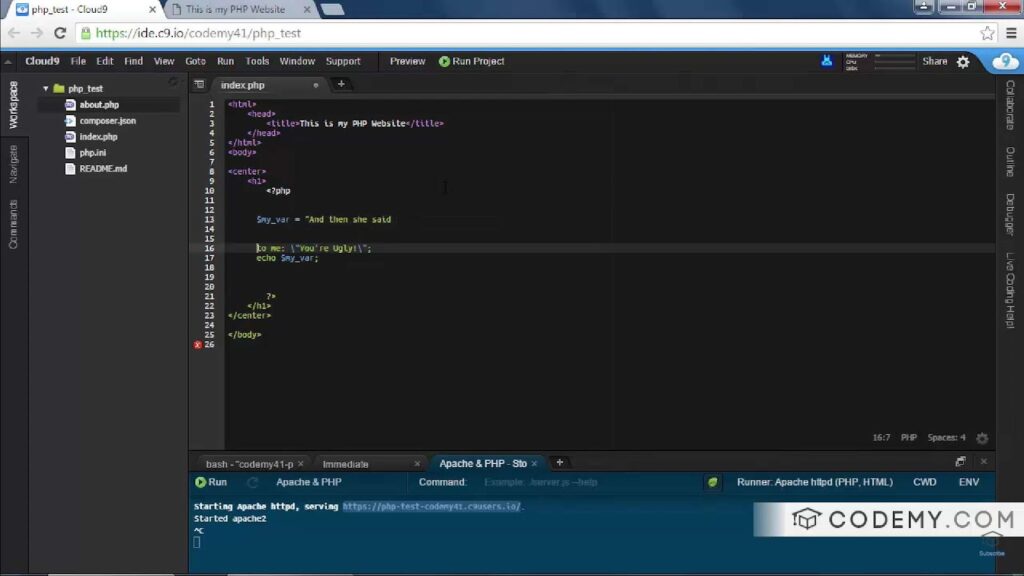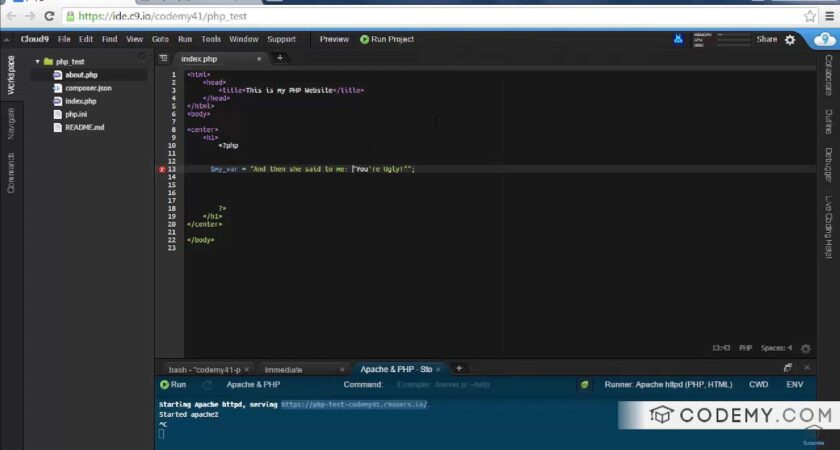Escape sequences play a pivotal role in numerous programming languages, with PHP being no exception. These invaluable tools empower developers to seamlessly incorporate special characters and control codes into strings, effectively averting any potential confusion that could arise during compilation. This article takes an in-depth plunge into the realm of escape sequences within PHP, shedding light on their functionalities and shedding light on prevalent scenarios in which they prove exceptionally beneficial.
Exploring Essential Escape Sequences in PHP
Within the realm of PHP programming, a deep understanding of escape sequences holds a crucial role in customizing strings to precisely match your requirements. Escape sequences serve as amalgamations of characters endowed with distinct meanings within the context of a string. In this comprehensive guide, we will embark on an exploration of the prevalent escape sequences in PHP, shedding light on their practical usefulness through illustrative examples. Also, dive into the Laravel magic with ‘Wherein,’ simplifying complex queries effortlessly. Uncover the secrets of Laravel Wherein!
Newline (\n)
Let’s delve into the newline escape sequence (\n), a fundamental tool for managing line breaks and creating well-structured text. When incorporated within a string, it instructs PHP to introduce a line break, effectively initiating a new line. Here’s a breakdown of how it operates:
echo "Hello\nWorld";Output:
Hello
World
Tips and Recommendations:
- Use \n when you want to structure your text with line breaks;
- Ideal for creating paragraphs or multi-line messages.
Tab (\t)
The tab escape sequence (\t) comes in handy when you need to insert horizontal tabs or indentation within your text. This helps in organizing information neatly:
echo "Name:\tJohn";Output:
Name: John
Tips and Recommendations:
- Employ \t to align columns or create an organized layout;
- Useful for generating tables or structured content.
Double Quote (“)
In PHP, double quotes (“) are used to define strings. To include a literal double quote within a double-quoted string, you can use the escape sequence (\”). This prevents PHP from interpreting the double quote as the end of the string:
echo "She said, \"Hello!\"";Output:
She said, “Hello!”
Tips and Recommendations:
- Essential when you need to include double quotes inside double-quoted strings;
- Useful for embedding HTML attributes or JavaScript code within PHP strings.
Single Quote (‘)
Similarly, to include a single quote within a single-quoted string, you can use the escape sequence (\’). This ensures that the single quote is treated as a character and not as the end of the string:
echo 'It\'s a beautiful day';Output:
It’s a beautiful day
Tips and Recommendations:
- Helpful for including single quotes within single-quoted strings;
- Commonly used when handling SQL queries or regular expressions.
Backslash ()
Sometimes, you might need to include a literal backslash within a string. To achieve this, you can escape it with another backslash (\\):
echo "C:\\xampp\\htdocs\\myproject";Output:
C:\xampp\htdocs\myproject
Tips and Recommendations:
- Necessary when you want a literal backslash in your string;
- Useful for representing file paths or regular expressions.
Null (\0)
The null escape sequence (\0) represents the null character and can be used within strings for specific purposes:
echo "This is a null character: \0";Output:
The null character is not visible in the output but is included in the string.
Tips and Recommendations:
- Rarely used in modern PHP programming, but it can be useful for specialized tasks;
- Can be employed in binary data manipulation or control characters.
By mastering these essential escape sequences in PHP, you gain greater control over the content and structure of your strings, enabling you to create more versatile and dynamic applications. Understanding when and how to use these sequences is a valuable skill for any PHP developer.
Exploring Unique Escape Sequences in PHP
Beyond the familiar escape sequences frequently employed in PHP, this versatile scripting language offers a range of special escape sequences, each with its unique purpose and potential applications. These special escape sequences may not see widespread use in contemporary web development, but they can certainly come in handy in specific scenarios, adding an extra layer of functionality and finesse to your code. Let’s delve into these special escape sequences and discover their hidden potential.
Carriage Return Character (\r)
The \r escape sequence is a valuable tool for controlling cursor movement in text-based applications. It represents a carriage return character, which is like hitting the “Return” or “Enter” key on a typewriter. Here’s how you can make the most of it:
When to Use \r:
- Formatting Text Output: In console applications, you can use \r to format text output effectively. It allows you to move the cursor to the beginning of the current line, making it handy for updating or overwriting text without creating new lines;
- Creating Progress Bars and Loading Animations: If you’re developing a command-line interface that provides real-time updates, \r can be your best friend. You can build custom progress bars or loading animations by repeatedly using \r to return to the start of the line and update the display.
Tips:
- Combine \r with other escape sequences or control characters for more advanced formatting;
- Use \r to create dynamic text displays that change in real-time based on application events.
Vertical Tab Character (\v)
The \v escape sequence introduces the vertical tab character, a less commonly used but still valuable tool. Think of it as a way to control vertical spacing within your text, allowing for more aesthetically pleasing layouts:
When to Use \v:
- Adjusting Line Spacing: In text documents or scripts where you need precise control over line spacing, \v can come in handy. You can use it to create distinct sections or improve the readability of your content;
- Creating Visual Layouts and Tables: Designing visually appealing vertical layouts or tables is easier with \v. It helps you align text or data rows with precision, making your output more structured and user-friendly.
Tips:
- Experiment with the number of \v sequences to achieve the desired spacing effect;
- Combine \v with other formatting techniques to enhance the overall visual impact of your text.
Form Feed Character (\f)
The \f escape sequence represents a form feed character, a powerful tool for managing multi-page documents and reports in console applications:
When to Use \f:
- Generating Multi-Page Documents: In scenarios where you need to create lengthy, multi-page documents within your command-line application, \f is the way to go. It advances the cursor to the next page, allowing you to organize your content effectively;
- Creating Complex Reports and Printouts: \f is indispensable for building complex, paginated reports or printouts. Whether you’re generating invoices, technical documentation, or extensive logs, this escape sequence ensures your output is organized and easy to navigate.
Tips:
- Combine \f with header and footer sections to add consistency and professionalism to your printed documents;
- Experiment with page numbering and formatting options to enhance the readability of your multi-page content.
Alert (Bell) Character (\a)
The \a escape sequence introduces the alert or bell character, which can provide users with audible or visual notifications within command-line applications:

When to Use \a:
- Notifying Users: When specific events or conditions require immediate user attention, \a can be your solution. It can produce an audible beep or trigger a visual alert, making sure your users are aware of critical information;
- Attention-Grabbing Notifications: In scripts or applications where timely notifications are vital, such as batch processes or monitoring systems, \a can be used to grab the user’s attention effectively.
Tips:
- Use \a sparingly and judiciously to avoid annoying users with excessive alerts;
- Combine \a with descriptive messages to provide context for the alert.
Backspace Character (\b)
The \b escape sequence represents a backspace character, a tool for creating interactive and user-friendly text-based interfaces:
When to Use \b:
- Interactive Menus and Forms: When designing command-line utilities that require user input, \b is essential. It allows you to move the cursor one position backward, enabling user-friendly editing features like erasing characters;
- User-Friendly Editing: Implementing features like backspace for character deletion can significantly improve the user experience in your command-line applications. \b helps users correct input mistakes easily.
Tips:
- Combine \b with other control characters like \r and \n to create well-structured and user-friendly menus and forms;
- Implement input validation to ensure data integrity when using \b for editing.
Conclusion
Escape sequences play a pivotal role in PHP, enabling seamless manipulation of strings replete with special characters and control codes. Proficiency in their adept usage can facilitate the development of code that is both adaptable and legible. Whether your endeavor involves the insertion of line breaks, tabs, or the circumvention of quotation marks, PHP offers an array of escape sequences to expedite the realization of your programming aspirations.
